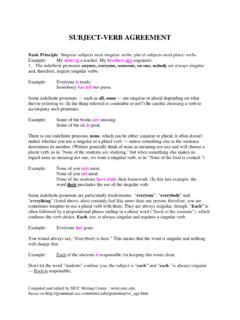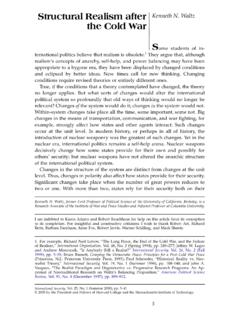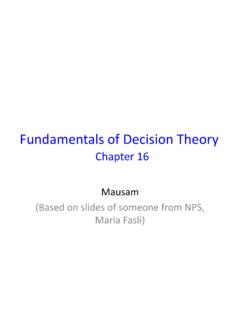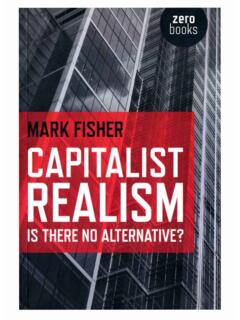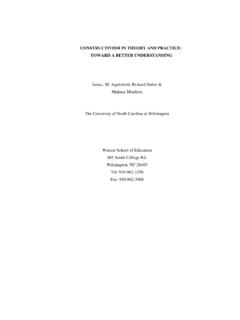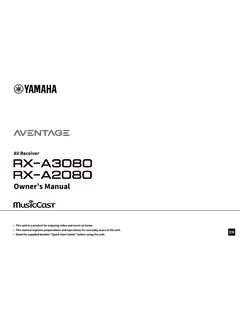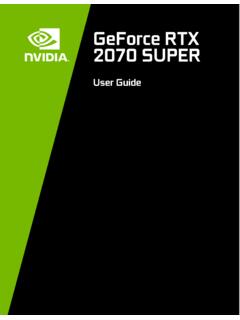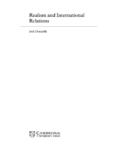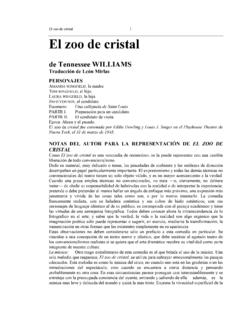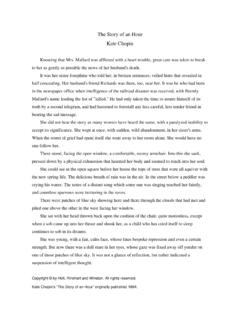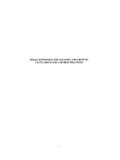Transcription of Annotated Bibliography Examples - The Writing Center
1 SIUC Writing Center ~write Writing AN Annotated Bibliography From Writing Across the Curriculum by Sandra Nagy Why write an Annotated Bibliography ? You can discover what your source contains (analysis). You can discover how best to use that information in your paper (organization). You can discover how to restate your topic into a working thesis (purpose). Rules to follow: Take your sources one at a time. Answer the questions in COMPLETE SENTENCES. The first 3 questions: What is the main, or most significant idea of this source? What is the author trying to do (purpose)? Who do you think is the author s intended audience?
2 Combine the Answers: Example: Smith focuses on the dropping illiteracy levels among school children, categorizing socioeconomic levels, racial groups, and parents educational background. Aiming at a general audience, Smith attempts to convince his readers that most children do poorly in school because their parents don t work with them in home study sessions. The next two questions: What parts of the subject does the source emphasize or de-emphasize? What assumptions does the author make about the topic or audience? Again, you combine the answers: Example: The author emphasizes that parents need to be more involved in their children s education and assumes that these parents have the time, the expertise, and the inclination to do so.
3 The final three questions: Is there any bias or slant in the source? Are there obvious omissions that seem important to the ideas being discussed? Does the evidence clearly support the author s main points? The last sentences: Example: While Smith s data supports his position, his solutions seem too simplistic and very general. Because he ignores the busy schedules, as well as the attitudes and expectations of some parents, his just do it advice doesn t seem likely to change the situation. Extra Tips: Write SHORT paragraphs. Combine answers where possible. Have 5-8 sentences that accurately describe the information and ideas from each source in your Bibliography .
4 Use an MLA type Works Cited page with a paragraph of analysis for each source. Last Points: Use alphabetical order. Double space everything. Leave two double-spaces between sources. SIUC Writing Center ~write MLA Annotated Bibliography Examples Cook, Sybilla. Instruction Design. New York: Garland, 1986. This book provides an Annotated Bibliography of sources concerning instructional patterns for research libraries. Written for an academic audience, the author provides information on how such a Bibliography can be used. Although it does not provide information on how to compile an Annotated Bibliography , the book proves a good source for Examples .
5 Harmon, Robert. Elements of Bibliography . American Scholar 65 (1989): 24-36. Although this article from a scholarly journal does not focus on Annotated bibliographies, the author does a superior job of indicating the reason and process of general Bibliography . Harmon writes this text for librarians who must focus on detailing books. The Bibliography for this text is Annotated and provides a good source of Examples . Mitchell, Jason. PMLA Letter. 1991. 23 May 1996. <http:10/28/2008 >. Mitchell protests the pretentious gibberish of modern literary critics in his letter to PMLA.
6 He argues that Eurojive is often produced by English professors to show that their status is equal to that of math and science faculty. His sense of humor makes this letter a great read. Beebe, Maurice. Ivory Towers and Sacred Founts: The Artist as Hero in Fiction from Goethe to Joyce. New York: New York University Press, 1964. This is a fascinating study of the writer's dual identity as artist and as individual. The source seems good for ideas about objectifying intensely personal experiences. SIUC Writing Center ~write Cassill, Writing Fiction. Englewood Cliffs: Prentice-Hall, 1975.
7 This book is of exceptional quality. Principles and technique as well as concepts are illustrated throughout by referencing the short stories reprinted in Section Two. Original ideas for overcoming writer's block are covered in Chapter 4. "Finger Exercises" with specific instructions on how to imitate other writers is also discussed. Chapter 5, "Notebooks and Lists," parallels the writer's notebook with the artist's sketchbook and offers suggestions for making the notebook an incubator of the imagination. Engle, Paul, ed. On Creative Writing . New York: E. P. Dutton, 1966. This is a collection of high quality articles, including Engle's introductory piece garnered from his years as the driving force behind the Iowa Workshop.
8 Appended short stories support the essays, which include ideas about poetry, the novel, drama, and non-fiction. Hildick, Wallace. Thirteen Types of Narrative: A Practical Guide on How to Tell a Story. New York: Clarkson N. Potter, 1970. This book is a lucid demonstration of the inseparable relationship between form and content as the author narrates the "basic story situation" from thirteen different points of view. Aaron, Jane E., ed. The Little, Brown Compact Handbook. 3rd ed. New York: Addison-Wesley Educational Publications Inc., 1998. This handbook is a highly useful and cogently organized style guide with tabbed sections on process Writing , clarity, grammar, punctuation, form, research, specialized Writing , and several documentation styles.
9 The comprehensive index aids in the quick and easy location of topics. SIUC Writing Center ~write MLA Annotated Bibliography Examples II Kintz, Linda. The Sanitized Spectacle: What s Birth Got to Do with It? Adrienne Kennedy s A Movie Star Has to Star in Black and White. Theatre Journal 44 (1992): 67-86. In a heavily theoretical article, Kintz draws on critics and theorists including Kristeva to address the issue of female specificity (particularly the references to bleeding and miscarriage) in Kennedy s play. This female specificity disrupts the cultural norms that choose to ignore certain aspects of bloody femininity, instead constructing women like Charlotte (Bette Davis s character in Now, Voyager) asexual, pure, abstracted mother figure[s] (75).
10 Kintz relates this to the privilege of indifference to legitimacy, but never really defines what she means by this phrase. Said, Edward W. The World, the Text, and the Critic. The World, The Text and the Critic. Cambridge: Harvard UP, 1983. 31-53. Said argues that texts are enmeshed in circumstance, time, place, and society (35) and that language, or a text, has a specific situation.(35) This conclusion means that texts do not have limitless interpretations (39). One other interesting point Said makes is that discourse is not a democratic exchange as some describe it. Rather, texts are fundamentally facts of power, not of democratic exchange ; discourse is usually like the unequal relation between colonizer and colonized, oppressor and oppressed (45,48).
